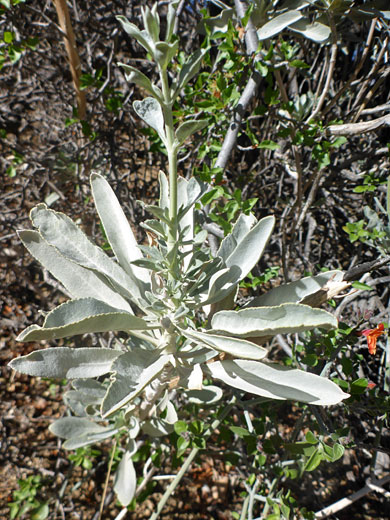Common name:
White sage
Family:
Scientific name:
Salvia apiana
Main flower color:
Range:
Southern California
Height:
Up to 6 feet
Habitat:
Chaparral, coastal scrub, pinewoods; up to 3,000 feet
Leaves:
Lanceolate, tapered at the base, shallowly toothed, light-grey; up to 3 inches long
Season:
April to August
Leaves of salvia apiana appear light grey due to a dense, even covering of short, unbranched, appressed hairs. Leaves are lined by tiny, rounded teeth, and they taper smoothly at the base to the short petiole. This species has relatively limited distribution, restricted to far southwest California, where it is abundant - between San Diego and Santa Barbara, and to 50 or 60 miles inland.
Flowers are produced in whorled, elongated clusters from the upper leaf nodes, subtended by bracts. Calyces are hairy, around 0.3 inches long, shallowly divided into two lips (one three-lobed, the other two-lobed), while the corollas, white to pale lavender, are up to 0.8 inches long, with an upper lip and a longer, upcurved, three-lobed lower lip. Two stamens and one style project some way beyond the corolla.
Flowers are produced in whorled, elongated clusters from the upper leaf nodes, subtended by bracts. Calyces are hairy, around 0.3 inches long, shallowly divided into two lips (one three-lobed, the other two-lobed), while the corollas, white to pale lavender, are up to 0.8 inches long, with an upper lip and a longer, upcurved, three-lobed lower lip. Two stamens and one style project some way beyond the corolla.
All Contents © Copyright The American Southwest | Comments and Questions | Contribute | Site Map


